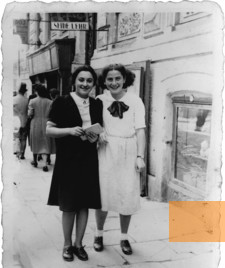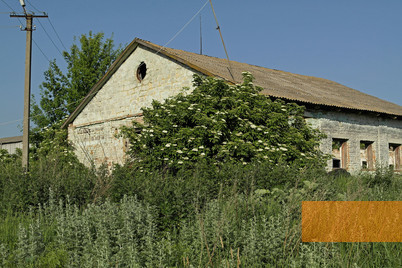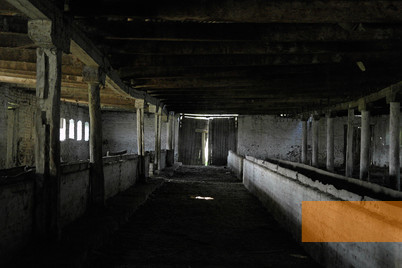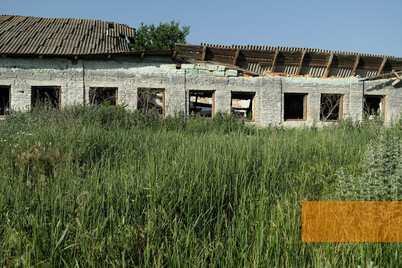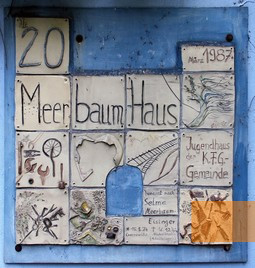In the village of Mychailivka (Russian: Michailovka) nothing reminds today of the murdered Jews of the labour camp, where many Jews from the surrounding area, but also from Chernivtsi (German: Czernowitzm, Rumanian: Cernăuți) perished. Among the victims was also the German-speaking poet Selma Meerbaum-Eisinger (1924-1942).
The village of Mychailivka (Russian: Michailovka) is located about 10 kilometers east of the city of Haisyn (Russian: Gaysin). The German Wehrmacht occupied the village at the end of July 1941, and from then on Mychailivka was located at a strategic road that served the Wehrmacht to control the occupied territories. Initially, the Germans recruited villagers for the road works and distributed small food rations as payment. Soon afterwards, SS units drove Jewish forced labourers from neighbouring areas into the village and set up a forced labor camp for them. It comprised of two barns surrounded by a barbed wire fence and was guarded by Ukrainian and Lithuanian guards. Many Jews died of hunger and disease or were shot during construction work on the edge of the road between Mychailivka and Haisyn. Jews caught attempting to escape were hanged. From May 1942 onwards, the Germans drove Jews from the Romanian-occupied Transnistrian region to Mychailivka. Many of the deported Jews originally came from Chernivtsi and the broader Bukovina region, including the parents of the German-speaking poet Paul Celan (1920-1970), the poetess Selma Meerbaum-Eisinger (1924-1942) and the painter Arnold Daghani (1909-1985). From then on, the forced labour camp was located in a school building in the centre of the village. In the following months, the Germans and their accomplices murdered over 200 Jews. After a partisan attack on the village in August 1943, the Germans moved the camp to the village of Tarasivka 5 km away. Contemporary witnesses reported that the partisans managed to free over 100 camp inmates. In October 1943, the forced labour camp in Tarasivka numbered more than 350 Jews, mainly from the Romanian-occupied Transnistrian region. On December 10 ,1943, the Germans dissolved the camp and murdered all remaining prisoners.
In forced labour camps such as the one in Mychailivka, many Jews died because of the dreadful conditions or were murdered specifically by members of the SD (Security Service of the SS), the SS or their local helpers. In total, several hundred Jews passed through the Mychailivka camp. The data of individual mass shootings are known: On August 19, 1942 the Germans murdered 16 prisoners. In November 1942 they murdered another 107 Jews and on April 26, 1943 55 Jews in Mychailivka . The KdS (Commander of the Security Police) Zhytomyr and KdS (Commander of the Security Police) Kiev were responsible for these mass shootings. When the camp in Tarasivka was disbanded, the Germans murdered more than 350 remaining Jewish prisoners.
The Red Army liberated the Mychailivka region in mid-March 1944. Today there are no Jews living in the village and there are no reminders of the former camp or the murdered forced labourers. Some of the camp's buildings are still standing, but they are not marked as such. At the mass grave 1,5 km north-east of the village there is also no monument. Only a few Jewish symbols at the gate to the mass grave commemorate the victims. The site is occasionally maintained by local authorities and Jewish visitors.
1987 a house of the Kaiser-Friedrich-Gedächtnis-Gemeinde in the borough of Berlin-Tiergarten was named after the poet Selma Meerbaum-Eisinger. Her 58 surviving poems belong to the literary heritage of the German-Jewish culture of the Bukovina. They were first published in the 1970s and became known in the German-speaking area in the 1980s. The painter Arnold Daghani captured her last days in Mychailivka in a painting. He managed to flee to the Romanian-occupied Transnistrian region and survived the war.
1987 a house of the Kaiser-Friedrich-Gedächtnis-Gemeinde in the borough of Berlin-Tiergarten was named after the poet Selma Meerbaum-Eisinger. Her 58 surviving poems belong to the literary heritage of the German-Jewish culture of the Bukovina. They were first published in the 1970s and became known in the German-speaking area in the 1980s. The painter Arnold Daghani captured her last days in Mychailivka in a painting. He managed to flee to the Romanian-occupied Transnistrian region and survived the war.
- Name
- Pamjat pro wbitih ewreiw taboru Mychailiwka
- Address
-
vul. Zhovtneva
Mychailiwka


